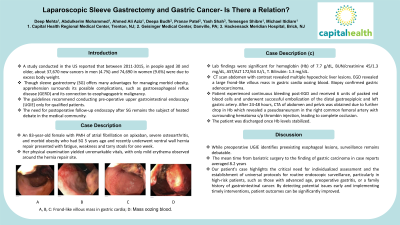Tuesday Poster Session
Category: Stomach
P4195 - Laparoscopic Sleeve Gastrectomy and Gastric Cancer: Is There a Relation?
Tuesday, October 24, 2023
10:30 AM - 4:00 PM PT
Location: Exhibit Hall

Has Audio
- DM
Deep Mehta, MD
Capital Health Regional Medical Center
Trenton, New Jersey
Presenting Author(s)
Deep Mehta, MD1, Abdulkerim Mohammed, MD1, Ahmed Ali Aziz, MD1, Deepa Budh, MD2, Pranav Patel, MD3, Yash Shah, MD4, Temesgen Shibre, MD5, Michael Itidiare, DO1
1Capital Health Regional Medical Center, Trenton, NJ; 2St. Barnabas Hospital, Bronx, NY; 3Geisinger Medical Center, Danville, PA; 4Ocean University Medical Center, Aberdeen, NJ; 5Capital Health Regional Medical Center, Hamilton, NJ
Introduction: A study conducted in the US reported that between 2011-2015, in people aged 30 and older, about 37,670 new cancers in men (4.7%) and 74,690 in women (9.6%) were due to excess body weight. Though sleeve gastrectomy (SG) offers many advantages for managing morbid obesity, apprehension surrounds its possible complications, such as gastroesophageal reflux disease (GERD) and its connection to esophagogastric malignancy. The guidelines recommend conducting pre-operative upper gastrointestinal endoscopy (UGIE) only for qualified patients. The need for postoperative follow-up endoscopy after SG remains the subject of heated debate in the medical community.
Case Description/Methods: An 83-year-old female with a medical history of atrial fibrillation on apixaban, severe osteoarthritis, and morbid obesity who had SG 5 years ago and recently underwent ventral wall hernia repair presented with fatigue, weakness and tarry stools for one week. Her physical examination yielded unremarkable vitals, with only mild erythema observed around the hernia repair site. Lab findings were significant for hemoglobin (Hb) of 7.7 g/dL, BUN/creatinine 45/1.3 mg/dL, AST/ALT 172/64 IU/L, T. Bilirubin: 1.3 mg/dL. CT scan abdomen with contrast revealed multiple hypoechoic liver lesions. EGD revealed a large frond-like villous mass in gastric cardia oozing blood. Biopsy confirmed gastric adenocarcinoma. Patient experienced continuous bleeding post-EGD and received 6 units of packed red blood cells and underwent successful embolization of the distal gastroepiploic and left gastric artery. After 24-48 hours, CTA of abdomen and pelvis was obtained due to further drop in Hb which revealed a pseudoaneurysm in the right common femoral artery with surrounding hematoma s/p thrombin injection, leading to complete occlusion. The patient was discharged once Hb levels stabilized.
Discussion: While preoperative UGIE identifies preexisting esophageal lesions, surveillance remains debatable. The mean time from bariatric surgery to the finding of gastric carcinoma in case reports averaged 8.2 years. Our patient's case highlights the critical need for individualized assessment and the establishment of universal protocols for routine endoscopic surveillance, particularly in high-risk patients, such as those with advanced age, preoperative gastritis, or a family history of gastrointestinal cancer. By detecting potential issues early and implementing timely interventions, patient outcomes can be significantly improved.

Disclosures:
Deep Mehta, MD1, Abdulkerim Mohammed, MD1, Ahmed Ali Aziz, MD1, Deepa Budh, MD2, Pranav Patel, MD3, Yash Shah, MD4, Temesgen Shibre, MD5, Michael Itidiare, DO1. P4195 - Laparoscopic Sleeve Gastrectomy and Gastric Cancer: Is There a Relation?, ACG 2023 Annual Scientific Meeting Abstracts. Vancouver, BC, Canada: American College of Gastroenterology.
1Capital Health Regional Medical Center, Trenton, NJ; 2St. Barnabas Hospital, Bronx, NY; 3Geisinger Medical Center, Danville, PA; 4Ocean University Medical Center, Aberdeen, NJ; 5Capital Health Regional Medical Center, Hamilton, NJ
Introduction: A study conducted in the US reported that between 2011-2015, in people aged 30 and older, about 37,670 new cancers in men (4.7%) and 74,690 in women (9.6%) were due to excess body weight. Though sleeve gastrectomy (SG) offers many advantages for managing morbid obesity, apprehension surrounds its possible complications, such as gastroesophageal reflux disease (GERD) and its connection to esophagogastric malignancy. The guidelines recommend conducting pre-operative upper gastrointestinal endoscopy (UGIE) only for qualified patients. The need for postoperative follow-up endoscopy after SG remains the subject of heated debate in the medical community.
Case Description/Methods: An 83-year-old female with a medical history of atrial fibrillation on apixaban, severe osteoarthritis, and morbid obesity who had SG 5 years ago and recently underwent ventral wall hernia repair presented with fatigue, weakness and tarry stools for one week. Her physical examination yielded unremarkable vitals, with only mild erythema observed around the hernia repair site. Lab findings were significant for hemoglobin (Hb) of 7.7 g/dL, BUN/creatinine 45/1.3 mg/dL, AST/ALT 172/64 IU/L, T. Bilirubin: 1.3 mg/dL. CT scan abdomen with contrast revealed multiple hypoechoic liver lesions. EGD revealed a large frond-like villous mass in gastric cardia oozing blood. Biopsy confirmed gastric adenocarcinoma. Patient experienced continuous bleeding post-EGD and received 6 units of packed red blood cells and underwent successful embolization of the distal gastroepiploic and left gastric artery. After 24-48 hours, CTA of abdomen and pelvis was obtained due to further drop in Hb which revealed a pseudoaneurysm in the right common femoral artery with surrounding hematoma s/p thrombin injection, leading to complete occlusion. The patient was discharged once Hb levels stabilized.
Discussion: While preoperative UGIE identifies preexisting esophageal lesions, surveillance remains debatable. The mean time from bariatric surgery to the finding of gastric carcinoma in case reports averaged 8.2 years. Our patient's case highlights the critical need for individualized assessment and the establishment of universal protocols for routine endoscopic surveillance, particularly in high-risk patients, such as those with advanced age, preoperative gastritis, or a family history of gastrointestinal cancer. By detecting potential issues early and implementing timely interventions, patient outcomes can be significantly improved.

Figure: Oozing Gastric Mass on EGD
Disclosures:
Deep Mehta indicated no relevant financial relationships.
Abdulkerim Mohammed indicated no relevant financial relationships.
Ahmed Ali Aziz indicated no relevant financial relationships.
Deepa Budh indicated no relevant financial relationships.
Pranav Patel indicated no relevant financial relationships.
Yash Shah indicated no relevant financial relationships.
Temesgen Shibre indicated no relevant financial relationships.
Michael Itidiare indicated no relevant financial relationships.
Deep Mehta, MD1, Abdulkerim Mohammed, MD1, Ahmed Ali Aziz, MD1, Deepa Budh, MD2, Pranav Patel, MD3, Yash Shah, MD4, Temesgen Shibre, MD5, Michael Itidiare, DO1. P4195 - Laparoscopic Sleeve Gastrectomy and Gastric Cancer: Is There a Relation?, ACG 2023 Annual Scientific Meeting Abstracts. Vancouver, BC, Canada: American College of Gastroenterology.
